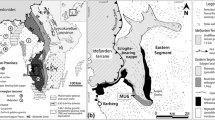Abstract
A temperature–time path was constructed for high-temperature low-pressure (HT–LP) migmatites of the Bayerische Wald, internal zone of the Variscan belt, Germany. The migmatites are characterised by prograde biotite dehydration melting, peak metamorphic conditions of approximately 850 °C and 0.5–0.7 GPa and retrograde melt crystallisation at 800 °C. The time-calibration of the pressure–temperature path is based on U–Pb dating of single zircon and monazite grains and titanite separates, on 40Ar/39Ar ages obtained by incremental heating experiments on hornblende separates, single grains of biotite and K-feldspar, and on 40Ar/39Ar spot fusion ages of biotite determined in situ from sample sections. Additionally, crude estimates of the duration of peak metamorphism were derived from garnet zoning patterns, suggesting that peak temperatures of 850 °C cannot have prevailed much longer than 2.5 Ma. The temperature–time paths obtained for two areas approximately 30 km apart do not differ from each other considerably. U–Pb zircon ages reflect crystallisation from melt at 850–800 °C at 323 Ma (southeastern area) and 326 Ma (northwestern area). The U–Pb ages of monazite mainly coincide with those from zircon but are complicated by variable degrees of inheritance. The preservation of inherited monazite and the presence of excess 206Pb resulting from the incorporation of excess 230Th in monazite formed during HT–LP metamorphism suggest that monazite ages in the migmatites of the Bayerische Wald reflect crystallisation from melt at 850–800 °C and persistence of older grains at these temperatures during a comparatively short thermal peak. The U–Pb ages of titanite (321 Ma) and 40Ar/39Ar ages of hornblende (322–316 Ma) and biotite (313–309 Ma) reflect cooling through the respective closure temperatures of approximately 700, 570–500 and 345–310 °C published in the literature. Most of the feldspars' ages (305–296 Ma) probably record cooling below 150–300 °C, while two grains most likely have higher closure temperatures. The temperature–time paths are characterised by a short thermal peak, by moderate average cooling rates and by a decrease in cooling rates from 100 °C/my at temperatures between 850–800 and 700 °C to 11–16 °C/my at temperatures down to 345–310 °C. Further cooling to feldspar closure for Ar was probably even slower. The lack of decompressional features, the moderate average cooling rates and the decline of cooling rates with time are not easily reconciled with a model of asthenospheric heating, rapid uplift and extension due to lithospheric delamination as proposed elsewhere. Instead, the high peak temperatures at comparatively shallow crustal levels along with the short thermal peak require external advective heating by hot mafic or ultramafic material.
Similar content being viewed by others
Author information
Authors and Affiliations
Additional information
Received: 7 July 1999 / Accepted: 28 October 1999
Rights and permissions
About this article
Cite this article
Kalt, A., Corfu, F. & Wijbrans, J. Time calibration of a P–T path from a Variscan high-temperature low-pressure metamorphic complex (Bayerische Wald, Germany), and the detection of inherited monazite. Contrib Mineral Petrol 138, 143–163 (2000). https://doi.org/10.1007/s004100050014
Issue Date:
DOI: https://doi.org/10.1007/s004100050014



